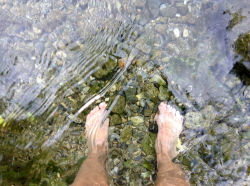Embracing Curiosity: The Heart of Nature Therapy Walks
- Jo Moore
- Jul 12, 2024
- 3 min read

In our modern society, characterized by its hectic pace and never-ending distractions, the idea of engaging in a nature therapy walk presents a unique opportunity for individuals to reconnect with the natural world and find solace amidst the chaos. These walks provide a much-needed escape from the hustle and bustle of daily life, a refreshing and grounding experience, allowing participants to immerse themselves in the beauty and tranquility of the outdoors.
While having knowledge about the various plants, animals, and ecosystems encountered during a nature therapy walk can certainly enhance the experience, it is curiosity that serves as the driving force behind a truly meaningful interaction with nature. Here’s why curiosity is more important than knowledge when embarking on a nature therapy walk.
The Essence of Embracing Curiosity
Curiosity is the innate desire to explore, learn, and understand the world around us. It is an active process, encouraging us to ask questions and seek answers. Unlike knowledge, which can sometimes be static, curiosity is dynamic and ever-evolving. It propels us to see beyond the surface and delve deeper into the mysteries of the natural world.
Engaging the Senses
When we approach a nature therapy walk with curiosity, we engage our senses more fully. Instead of merely identifying plants or animals by name, we become attuned to the myriad of sounds, smells, textures, and sights that surround us. The rustling of leaves, the chirping of birds, the earthy scent of the forest floor—these sensory experiences become more vivid and meaningful when we are driven by curiosity.

Fostering a Connection with Nature
Curiosity fosters a deeper connection with nature. Rather than viewing the natural world as a collection of isolated facts, we begin to see it as an interconnected web of life. This holistic perspective allows us to appreciate the delicate balance of ecosystems and our place within them. When we are curious, we develop empathy for the creatures and plants we encounter, recognizing their intrinsic value and role in the environment.
Encouraging Mindfulness
A curious mind is a mindful mind. When we are curious, we focus on the present moment, fully immersing ourselves in the experience. This mindfulness reduces stress and promotes a sense of peace and well-being. It allows us to temporarily set aside our worries and concerns, giving us the mental space to recharge and rejuvenate.
Inviting Serendipity
Curiosity invites serendipity—the joy of unexpected discoveries. On a nature therapy walk, this might mean stumbling upon a hidden grove, observing a rare bird, or noticing the intricate patterns of a spider's web. These serendipitous moments bring a sense of wonder and delight, enriching our experience in ways that knowledge alone cannot.
Promoting Lifelong Learning

While knowledge is valuable, it can sometimes create a false sense of completeness. Curiosity, on the other hand, reminds us that there is always more to learn and discover. It keeps our minds open and flexible, encouraging lifelong learning. In the context of nature therapy walks, this means continually finding new aspects of nature to marvel at and learn about, ensuring that each walk is unique and fulfilling.
Enhancing Creativity
When we embrace curiosity, it enhances creativity by encouraging us to think outside the box. When we are curious, we ask questions and seek answers, often leading to new ideas and perspectives. This creative thinking can be therapeutic, offering solutions to problems and inspiring new ways of interacting with the world around us.
Conclusion

In conclusion, while knowledge about nature can enhance our understanding and appreciation of the natural world, it is curiosity that truly transforms a nature therapy walk into a profound and enriching experience. Curiosity engages our senses, fosters a connection with nature, promotes mindfulness, invites serendipity, encourages lifelong learning, and enhances creativity. So, the next time you embark on a nature therapy walk, let your curiosity lead the way. Embrace the unknown, ask questions, and allow yourself to be awed by the wonders of nature. In doing so, you will find that the journey becomes as meaningful as the destination.





Comments